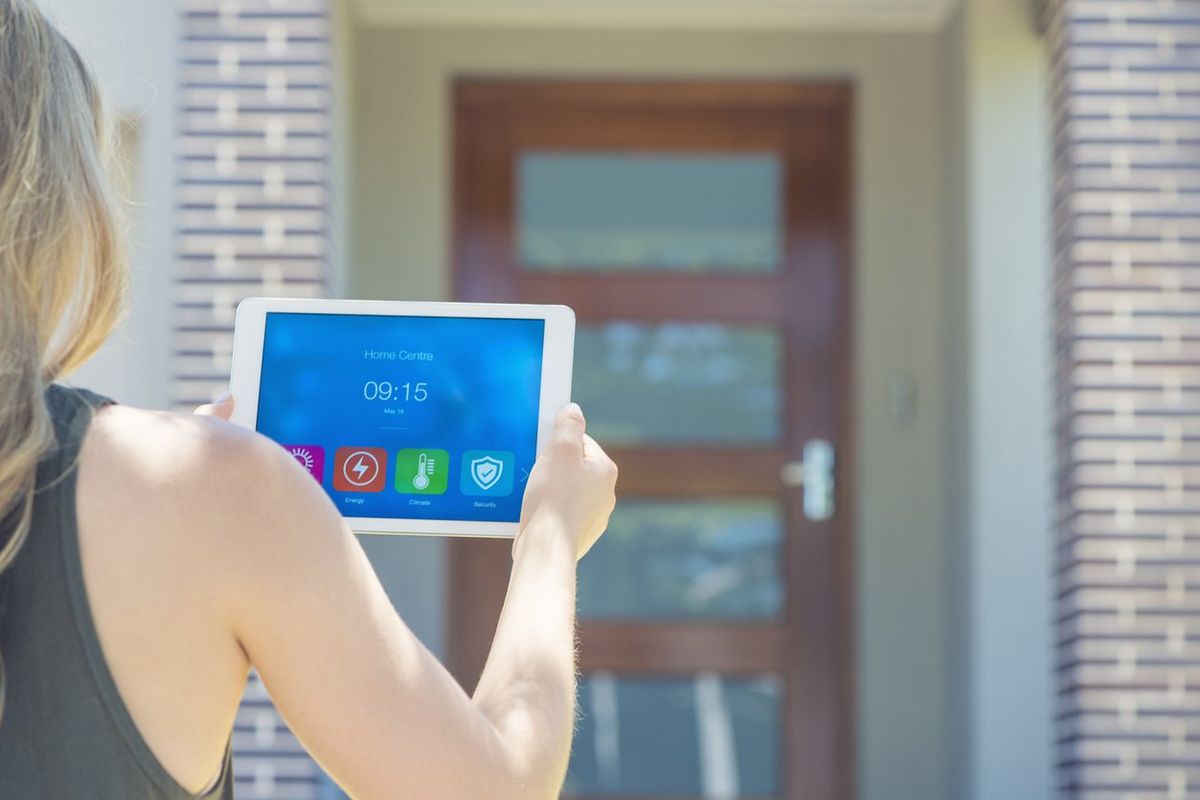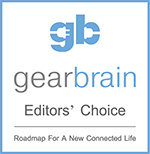
iStock
The ideal smart home devices for property owners to install for renters
Without landlords, homeowners have ultimate freedom when it comes to making their houses smarter for renters.

Without landlords, homeowners have ultimate freedom when it comes to making their houses smarter for renters.

There is so much more to the smart home of 2024 than an Alexa smart speaker or display, a Wi-Fi door lock, and some color-changing smart LED bulbs. But, as we have previously addressed at GearBrain, those who live in rented accommodation are restricted with just how smart they can make their homes. Thermostats, smart switches, outlets, and locks, for instance, are mostly off the table.
But with your own property, things are often quite different. Here, with the freedom to change door locks, dig up gardens, and even replace the entire plumbing and electricity if you so wish, the limits for smartness go as far as your imagination or your budget.
What follows is GearBrain's guide to the most popular smart home products available to homeowners. This is by no means a complete list, but it serves as an overview of what smart devices are available and what can be installed to make your home smarter.
We'll also address issues with installing devices in shared buildings like apartment blocks, where issues like a security camera with a view of your neighbor's driveway or a video doorbell looking into a shared hallway come into play.

Just like the building itself, your smart home needs to be built on solid foundations. This means your internet connection, home network, and — as has increasingly become the case in recent years — a smart speaker or display from the Google Home (now called Nest) and Amazon Echo ecosystems.
Owners in larger homes or older properties with thick walls should begin by searching for any black spots in their Wi-Fi network coverage. This is because almost all smart home devices rely on a wireless connection, either to your router directly or to a hub plugged into the router. So-called mesh networks can help remove black spots by using several hubs, also known as nodes or points, to broadcast Wi-Fi throughout the property. Another option is to get a Wi-Fi 6 router. Wi-Fi 6 routers provide faster speeds, better performance, improved efficiency, extended coverage, and enhanced security, making them a worthwhile investment for users looking to upgrade their home or office network. These routers come in mesh systems, which allow you to get excellent coverage in large homes.
For instance, installing two or three Nest Wi-Fi (2021) points should be enough for most large houses unless you happen to live in a Scottish castle and demand 4K Netflix in every turret.
Small and medium-sized properties might work perfectly with the router offered by your Internet Service Provider, but if coverage is patchy, a better Wi-Fi 6 router or a mesh network from Google Nest, Amazon-owned Eero, TP-Link Deco, or Netgear's Orbi could help your smart home run more smoothly. You might also want to consider installing Ethernet cables for a solid connection in every room, but this isn't as necessary as it once was.
Lastly, it is worth considering replacing your wall outlets with ones fitted with additional USB ports and integrated smartness. Or, if your budget won't allow it, then you could pick up a few extension cables with USB ports. If your home is anything like ours, you'll need every last port to keep a house full of smartphones, tablets and other devices powered.
Read More:

Next, you will want to buy a hub to control your smart home. While this isn't strictly necessary for most of the simpler items - smart lights, locks, and cameras can all work with their own hub and app - voice control and automation features offered by Amazon Alexa and Google Assistant, as well as Apple and Siri, are hard to ignore. And they make the perfect hub for your smart home.
The Google Home/Nest and Amazon Echo systems are a good place to start, with the former generally better at answering questions and internet search queries, while the latter offers a marginally more complete smart home control system. There's nothing stopping you from buying both, but using both systems to control your home will quickly get confusing, so we recommend you pick one and stick to it.
Samsung SmartThings is another option, especially if you aren't interested in using a voice assistant to control your home (although SmartThings can be controlled with Alexa and Google Assistant if you so wish). SmartThings sells a hub as a standalone or built-in to their new smart TVs, plus a range of sensors and other smart home accessories, and is compatible with many devices from other smart home devices.
Apple is also a player here, albeit with a far smaller share of the market. The HomeKit app for iOS can be used to control smart home devices, with the Apple TV, HomePod mini, or iPad acting as a hub, and you can control devices like lights, plugs, door locks, and the garage door by speaking to Siri.
If you opt for Google Home or Amazon Alexa, you'll want to buy additional Echo Dot or Nest Mini speakers and place them throughout the home, where they can hear your instructions and speak back to you. Alternatively, products like light switches by iDevices, smart TVs by Samsung or LG, and the Ecobee SmartThermostat have Alexa built in — but remember that Alexa run on non-Amazon products does not always have the same features as an Echo, as is the case with the Sonos One speaker. (Note: Sonos's new smart speakers, Sonos Era 100 and Era 300, have Amazon Alexa built-in and can function like an Echo smart speaker. You need to have an Alexa account.)
Read More:

As we explained in our guide to smart home tech for renters, smart lights are among the easiest to install and set up. Unless market leaders like Philips Hue and LIFX don't offer bulbs compatible with your fittings (in which case you'll need to modify yours or install new ones), fitting smart lights is very simple and a great thing to expand over time. Also, these smart devices can help property owners reduce energy consumption and lower utility bills. And they can be used to enhance your home's security when connected to a motion sensor.
Homeowners have the extra freedom of fitting lights wherever they like, but otherwise, this is one area of the smart home that can be enjoyed by just about everyone.
Unlike renters, homeowners or Airbnb owners are likely more inclined to work on their gardens, which is where outdoor Hue lighting comes into play. Launched in 2018, the ever-expanding range includes lights for illuminating pathways and flowerbeds and for mounting to your external walls.
Other internal smart lighting options include bulbs by Wiz, Ikea, Cync (GE Lighting), Nanoleaf, and Sengled.
Read More:

Similarly, smart plugs are a great way to make your home smarter without breaking the bank. Plug something like the TP-Link Smart Plug into a wall outlet, connect it to your Wi-Fi network via the included app, plug a device into the smart plug, and that product can now be switched on or off with your phone or, with Alexa and Google Assistant support, your voice.
Just be aware that some devices don't fully power up when switched on at the plug. For example, most televisions fitted to a smart plug will only enter standby mode when powered up, although they will switch off on command.
More recently, manufacturers have offered smart wall outlets. These fit into the wall as normal but connect to your Wi-Fi network and can be controlled like a smart plug but without taking up any unnecessary space.
Overall, installing smart plugs or outlets can improve convenience, energy efficiency, security, and automation capabilities for property owners, making their homes or properties smarter and more efficient.
Read More:

Now, we're getting into areas where smart home renters and owners must go down separate paths. Where renters can put a Google Nest Cam Indoor/Outdoor or Wyze Cam on a shelf in the hallway, they are likely unable to get landlord permission to fit external cameras to the building. Homeowners have no such issues, so cameras like the Nest Cam Outdoor can be installed to monitor your garden, driveway, and external doors.
However, you should always bear in mind the privacy of your neighbors when setting up security cameras. For example, the house next door might object to your camera if it can see into their garden, even if your intention was for it to keep an eye on your garage.
Another consideration to make is if you live in an apartment block or other form of shared building. You might own your unit within the building, but a security camera focused on your doorstep will be recording in a private area that is not yours. As such, you should check with the owners or managers of the building before proceeding.
Once you have some cameras set up, you should consider helping them see at night with LIFX's 'night vision' bulbs, which emit invisible infrared light at night, giving bright and clear pictures for any infrared-equipped security camera nearby.

Video Doorbells often need wiring to your home's electrical supply, which is a problem for renters but means property owners can go right ahead and fit a new, smarter alternative. Manufacturers like Vivint, Arlo, Lorex, and Amazon-owned Ring and Blink all produce smart video doorbells with integrated cameras for seeing who is there and Wi-Fi for alerting you via your smartphone no matter where in the world you are.
The Ring Video Doorbell 4 conveniently can be powered by a wired connection to the house or by its own rechargeable battery, making it suitable for both renters and owners.
As with security cameras, you should be aware of where the video doorbell is pointing, what it can see, and how its recordings are captured, stored, and deleted. Doorbell cameras are designed to work best at close range, so a view of a house across the road is unlikely to cause concern, but it might be worth checking with your neighbors to be safe - even if that means explaining that the device is a doorbell and not a security camera recording 24/7.
You should also check with building management if you own an apartment, as the video doorbell camera will likely be facing a communal corridor and potentially at someone else's front door just a few feet away.
Read More:

This is another area where there is some crossover between renters and owners, but not much. Where renters might be able to install something like the August Smart Lock Pro, which uses your existing door and deadbolt, owners have the freedom to fit any option they like. This means other locks from August Home or alternatives from Yale, Kwikset, Level Lock, Schlage, or whoever you prefer.
Picking a smart lock will depend on what features you want from it, the configuration of your current lock, whether you would consider installing a new deadbolt, and, of course, which manufacturer you feel most deserves your trust. Some smart locks open with a PIN, others unlock when they detect your smartphone is nearby; most offer an option to grant temporary access to other people, like a housekeeper, and others work with Amazon's in-home delivery service, Key. (Kwikset Halo smart lock is another good smart lock that works with Amazon Key.)
Read More:

Now we are firmly into home-owning territory, as it is very unlikely that landlords will let a renter fit their property with a new thermostat. Units from Google-owned Nest, Honeywell, ecobee, Cync, Tado, Lux, and even Amazon's own Alexa smart thermostat connect to your Wi-Fi network and control your home's heating and cooling system.
They perform all regular thermostat duties like switching the hot water on according to a schedule or keeping the house at a set temperature. But they can also be adjusted remotely via your smartphone, and even alter their schedule based on your routine in a bid to lower your energy bills.
As well as smart thermostats, German smart home company Tado sells controls for each radiator in your home, so you can adjust the temperature on each using your smartphone, tablet (via app), or by speaking to Alexa. The system also adjusts based on the weather forecast.
Read More:

As fun as it is to control smart lights with Alexa, some aspects of smart home technology are more serious — but potentially worth their weight in gold. One such category is water leak detectors, which, at their simplest, detect when the floor becomes wet and let you know with a smartphone notification.
More complex systems, like those from Phyn and Moen's Flo, can automatically shut off your water supply in the event of a leak being detected. Phyn, which is part of the Belkin group (itself owned by iPhone manufacturer Foxconn), monitors your water flow 240 times per second to make sure everything is working correctly. The system learns over time to better tell the difference between regular water flow and a lack of pressure due to a leak.
Good water leak detectors to consider for your rental property are made by LeakSmart, Phyn, Kohler's H2Wise+, Moen's Flo, Flume, Vivint, Orbit, Fibaro, Eve, and D-Link.
Read More:

For homeowners with gardens, there are plenty of ways to make your yard smarter and more connected. Products like automatic sprinkler systems can be installed to help keep your lawn and plants fed, but also save you money by not wasting water. A sprinkler controller like the Rachio or Orbit B-hyve fits onto your existing system and can save you thousands of gallons of water every year - in testing, a friend of GearBrain saved 29,000 gallons in 12 months.
Systems like Rachio split your yard into zones (usually eight or 16) and you can tell a smartphone app what type of soil is in each zone, how much shade there is, and the type of vegetation growing there. You can leave the Rachio to do its thing, control things manually with the app - or issue commands to Alexa and Google Assistant. (Check out The GearBrain, our smart home compatibility find engine, to see the other compatible products that work with Google Assistant and Amazon Alexa-enabled devices.)
And if your home doesn't have a sprinkler system, no worries. You can use a new smart device called a smart water hose timer or controller. A smart water hose timer or controller is a device designed to automate and manage watering schedules for outdoor plants, gardens, and landscapes. Unlike traditional hose timers, which require manual adjustments and monitoring, smart water hose timers leverage internet connectivity and advanced scheduling features to optimize watering efficiency and conserve water. Just connect the smart water hose timer to your outdoor spiget and connect it to your home Wi-Fi network. Once connected, users can use the device's advanced scheduling features to maintain healthy, vibrant landscapes while conserving water and reducing water waste.
Who makes good smart water hose timers? Based on our testing, Orbit, Rachio, and Rainpoint make reliable smart water hose controllers.
Read More:

Another one for property owners - not least because of the high installation cost — is motorized window blinds. Manufacturers of such systems include Lutron, Pella, Somfy, Ikea, Ryse, SmartWings, and Wazombi, and they mostly do as you would expect - they raise and lower when you ask.
These systems each have their own physical controllers, but some also hook up to Alexa, Google Assistant, and Siri for that extra living-in-the-future touch. With Alexa and a house full of Lutron Serena blinds, you could, for example, say: "Alexa, good morning," and have the blinds all raised or set them through an Alexa Routine to lower at the same time each evening.
Not only is such a system fun and time-saving, but when combined with automated smart lights, it helps give the impression to potential burglars that your property is occupied even when it isn't.
That high cost we alluded to will, of course, depend on how many windows you have and what material you want to use, but with the cheapest systems starting at around $130 per blind, then quickly heading up to between $300 and $500, they represent a serious investment.
Read More:
GearBrain video on what you need to know before building a smart home.GearBrain
GearBrain Compatibility Find Engine
A pioneering recommendation platform where you can research,
discover, buy, and learn how to connect and optimize smart devices.
Join our community! Ask and answer questions about smart devices and save yours in My Gear.
